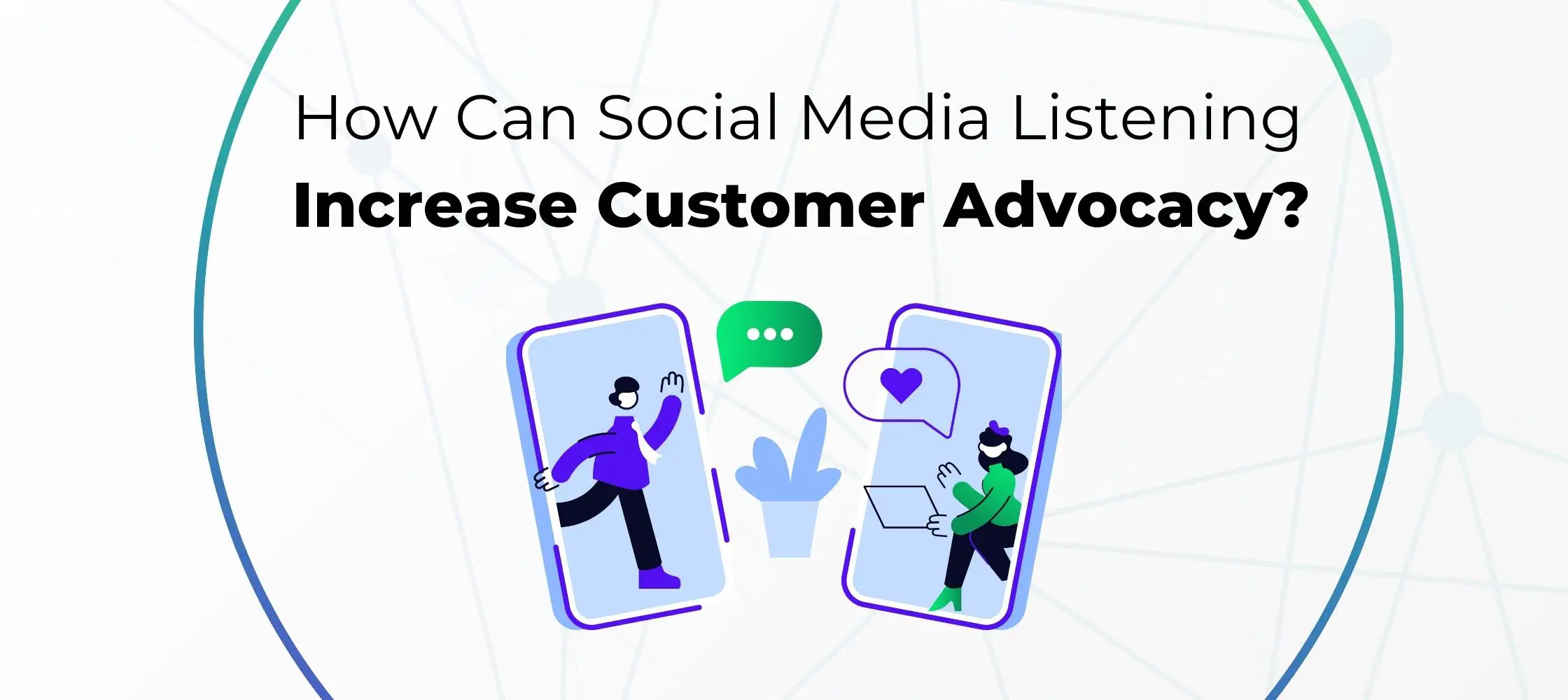
As brand marketers, we typically want more than just an audience that likes us – we want them to love us! One of the most effective ways to create this kind of brand affinity is to leverage customer advocacy. Below, we break down the importance of customer advocacy, social listening, and their benefits to your brand.
What is Social Media Listening?
Social media listening is the act of monitoring, identifying, and analyzing consumer conversations throughout social media platforms. Social media listening tools are what software marketers use to gather audience feedback, mentions of your brand, competitor mentions, and industry trends while protecting brands from potential crises.
Why does social media listening matter?
Social listening is important in a number of ways. The first is obvious – by listening to what your audience is saying and how they’re saying it, you have insider knowledge into your marketplace that others do not. Another major benefit is crisis mitigation. These tools track conversations in any way related to your brand so you can respond promptly. And then there is the fun part of the tool – identifying trends. Trendspotting early allows you to lead the crowd rather than follow.
What is customer advocacy?
Customer advocacy boils down to loyalty. It’s building a nurturing relationship with loyal customers who act as spokespeople for your brand, products, or services. When a brand creates these relationships, they have tapped into the customer advocacy side of the business. As a brand, we want your customers to feel so satisfied with your products or services that they share their satisfaction with other consumers. Customer satisfaction leads to these relationships and advocates for your brand.
Social listening comes into play with customer advocacy as a tool to fine-tune and personalize the customer experience. By listening to those social conversations, we are able to better understand our audience and then interact with them on a more personal, tailored level. We can use social listening to meet consumers where they’re at in a way that resonates with them best.
Why does customer advocacy matter?
Beyond creating a loyal customer base, customer advocacy is an outlet for constructing trust. Consumers want to feel heard, and they expect to be answered when reaching out, and advocacy is part of the overall brand experience — with 83 percent of consumers expecting a response from a brand within 24 hours.
Benefits of Creating Customer Advocacy
Creating customer advocacy matters for many reasons, like building brand awareness and presence, reaching potential customers through organic tactics (like word of mouth and creating shareable content), and differentiating your brand from your competitors. Customer advocacy is an avenue to connect with your customers while improving their experience with your brand, as loved brands create three times as much word-of-mouth than those without it. An added bonus is the positive effect of positioning your brand as trustworthy within your industry through consumers sharing their experiences.
Benefits of Social Media Listening
Social media listening offers access to any and all conversations (ahem, intel) users are having around your brand. Here are the top 7 benefits of social media listening.
- Know and understand your audience — knowing their wants and needs makes for easier connections.
- Internal brand and product awareness — uncover insights as to how your customers feel, what they like, and what they don’t like about your products/services.
- Crisis management — being able to identify a crisis before it happens or while it’s happening to address and alleviate the situation quickly, and understand what problem occurred that can be avoided in the future.
- Improve paid social strategies — being able to meet your audience where they are at or where they aspire to be, understanding audience nuances, retargeting based on specific behaviors, and taking advantage of new approaches your brand might not have otherwise (ex. in-game advertising).
- Increase customer advocacy — building solid relationships, connecting with your audience on a deeper level, and allowing customers to advertise for your brand just because they are happy with their experience.
- Tap into trends — being able to act on trends quickly as social trends typically have short lifespans, positioning the brand as relevant by using trends or showing authenticity and humor by entering trends (memes, TikTok sounds, current happenings like the GIFs from Rihanna’s Halftime Performance, etc).
- Content ideas and creation — being able to utilize certain content types based on your audience’s reactions and if the content resonated well with them in terms of engagement.
Reaping the benefits of social media listening doesn’t mean you have to take on all that work on your own. ICUC is here to help with social media listening tools and reporting.
Ways to Increase Customer Advocacy with Social Media Listening
Think of social listening as the stepping stones to creating those consumer/brand relationships, where each step (say a mention, conversation, or interaction) helps us to know our audience better and better. As your social listening strategy gets stronger, so does your ability to advocate, create, and respond on behalf of your customers’ needs and wishes.
Monitor social media mentions
Automatically and effortlessly keep your ear to the ground for any and all mentions users post around your brand. Are customers not loving the latest product launch? Has another brand mentioned you in a comment, cheekily? Has a video gone viral featuring your brand and an adorable pup? These scenarios teach you more about your audience, how and where they engage, and how best to suit their needs. Once you’re aware of the mention/sentiment, you can develop an action plan to best respond.
Engage with your audience
Engaging is one of the easiest and best ways to show our audiences that we hear them, acknowledge them, and know what’s going on within our social spaces. Engaging also offers the chance to tailor content to best suit your consumers’ needs and/or lifestyles — people will let us know how they feel and what they want to see as long as we are paying attention to them.
Make improvements based on feedback
It can be very hard to tell how a product or service is resonating with an audience without feedback. Feedback allows brands to implement changes based on real-life commentary and concerns while also letting us know what we are doing right (and what doesn’t need fixing). If X number of people are sharing the same issues, we can pivot to address those changes internally and then share externally to show that our brand not only heard but listened and adapted.
Reward customers by sharing their feedback
Rewarding customers could be through retweeting, sharing UGC across different channels, posting customer testimonials, and more! Sharing content directly from consumers who’ve made a purchase with our brand is an authentic way to bring trust and honesty to the forefront.
Understand your competitors and the industry
We can leverage competitor customer feedback to benefit our marketing plans. If an issue continuously gets reported, tracked, and escalated, the product team can use that information to either tweak the product or showcase the solution in marketing campaigns. Social listening also allows you to become a reliable source of information within the industry, as a category expert.
Those examples above are just the tip of the iceberg regarding how many avenues we can take to use social listening to our advantage. The more we know about our audience, the more ways we can reach them.
Best Practices for Social Listening
Social listening platforms vary in complexity, but in general, there is a set of best practices to make the most out of your time and effort using the tool. If you have trouble optimizing your tool, consider connecting with a social listening team.
Pin down your audience
Know your audience – their demographics, preferred social platforms, keyword usage, and as much information overall as you can. Search queries within social listening tools work best when the information provided is as detailed as possible: the more you know about your audience, the stronger the search results and audience analysis, which will aid in your content strategy.
Choose the right social listening tool
Not all social listening tools are created equal, and it’s imperative to use the best tool for the type of information we are looking for. For example, if you’re a small business with little staff and not a lot of social media background, Sprout Social is a great place to start. On the other hand, if you’re a bigger enterprise and interested in what the brand’s competitors are doing, Brandwatch or Sprinklr are ideal platforms. Fanpage Karma is also a great tool for TikTok and Instagram listening data.
The most important part of all of this is that whoever is using the tool is the expert, so you can reap its full benefits.
Create a plan for social listening
To start a social listening plan, consider the following questions:
- What are we hoping our social listening efforts result in?
- Where do we need to be tracking mentions/conversations?
- Who are we listening to?
We want to identify the goals and objectives we have for our brand as a way to measure success. These types of tools gather loads of information, and it’s easier to understand the data when we have something to measure against.
Track, monitor, and interact
Not every social user will spell your brand name right, or even list the right brand. Those nuances in conversation are called untagged mentions. This is why having a manual team behind your tool is essential.
Develop a crisis management plan
Have procedures set in place for different levels of severity that can be followed in the chance that the brand faces a crisis situation. Being able to identify issues in real time and knowing how to act on them, is crucial when time is of the essence (and in the fast-moving social world, time is always of the essence).
Conclusion
Becoming a beloved brand, with customers ready to shout your name from the rooftops just because they want to, is an achievable dream. But, it’s easier to achieve when we acknowledge and work on creating customer advocacy as a core marketing element. Customer advocacy It’s an everyday effort that can strengthen existing relationships, flourish potential relationships, and create loyalty that isn’t bought by the brand.
Looking to embark on social listening? Together, we can help you reach your customer advocacy goals. Contact us to learn more.
